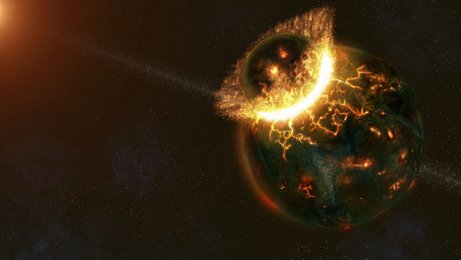Evidence of the world that crashed into the Earth billions of years ago to form the Moon has been found after researchers analyzed the lunar rock brought back by Apollo astronauts .
Analysis of lunar rock shows traces of the “planet” called Theia.
The researchers claim that their discovery confirms the theory that the Moon was created by just such a cataclysmic collision.
The study has been published in the journal Science.
The accepted theory since the 1980s is that the Moon arose as a result of a collision between the Earth and Theia planet 4.5 billion years ago.

The accepted theory since the 1980s is that the Moon arose as a result of a collision between the Earth and Theia planet 4.5 billion years ago
Theia was named after a goddess in Greek mythology who was said to be the mother Selene the goddess of the Moon. It is thought to have disintegrated on impact with the resulting debris mingling with that from the Earth and coalescing into the Moon.
It is the simplest explanation, and fits in well with computer simulations. The main drawback with the theory is that no one had found any evidence of Theia in lunar rock samples.
Earlier analyses had shown Moon rock to have originated entirely from the Earth whereas computer simulations had shown that the Moon ought to have been mostly derived from Theia
Now a more refined analysis of Moon rock has found evidence of material thought to have an alien origin.
According to the lead researcher, Dr. Daniel Herwartz, from the University of Goettingen, no one has found definitive evidence for the collision theory, until now.
But the difference, some say, could be explained by material absorbed by the Earth after the Moon formed.
Dr. Daniel Herwartz measured the difference in what is called the isotopic composition of the oxygen contained in rocks on Earth and Moon rock. This is the ratio of different forms of oxygen.
Studies of meteorites from Mars and the outer solar system show that these ratios are markedly different -rather like a fingerprint.
One possibility is that Theia was formed very close the Earth and so had a similar composition. If that was the case it raises the possibility that the assumption that each planet in the current Solar System has a markedly different fingerprint that needs to be revisited.
[youtube UfuyHB-uWSg 650]
Scientists have proposed a new idea in the long-running debate over the Moon formation.
What is certain is that some sort of impact from another body freed material from the young Earth and the resulting debris coalesced into today’s Moon.
But the exact details of the impactor’s size and speed have remained debatable.
In a report online to be published in Icarus, researchers suggest that the crash happened with a much larger, faster body than previously thought.
Such theories need to line up with what we know about the Moon, about the violent processes that set off the creation of moons, and what computer simulations show about the more sedate gravitational “gathering-up” that finishes the job.
In recent years, scientists’ best guess for how the Moon formed has been that a relatively slowly moving, Mars-sized body called Theia crashed into the very young Earth.

What is certain is that some sort of impact from another body freed material from the young Earth and the resulting debris coalesced into today's Moon
That would have heated both of them up and released a vast cloud of molten material, much of which cooled and clumped together to give rise to the Moon.
That would suggest that the Moon is made up of material from both the early Earth and from Theia, which should be somewhat different from one another.
What complicates that story is a number of observations of “isotopic compositions” – the ratios of naturally-occurring variants of some atoms – taken from the Earth and from lunar samples.
While the Moon has an iron core like Earth, it does not have the same fraction of iron – and computer models supporting the Theia impact idea show just the same thing.
However, the ratio of the Earth’s and the Moon’s oxygen isotopes is nearly identical, and not all scientists agree on how that may have come about.
Confounding the issue further, scientists reporting in Nature Geoscience in March said that a fresh analysis of lunar samples taken by the Apollo missions showed that the Moon and the Earth shared an uncannily similar isotope ratio of the metal titanium.
That, they said, gave weight to the idea that the Moon was somehow cleaved from the Earth itself.
Now, Andreas Reufer, of the Center for Space and Habitability in Bern, Switzerland, and colleagues have run computer simulations that suggest another possibility: that a far larger and faster-moving body made an even more glancing blow with the young Earth.
They said this body would have lost only a small amount of material and most of it would have continued on after the “hit-and-run”.
That results in a much hotter disc of debris from the collision, but matches up with what would be needed to make a Moon-sized body.
The authors suggest that since most of what became the Moon would have been liberated by the impact from the Earth, similarities between the isotope fractions should be more pronounced.
More analyses of different elements within lunar samples – and a great deal more computer simulations that result in a Moon like our own – will be needed to settle the debate.


